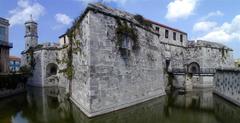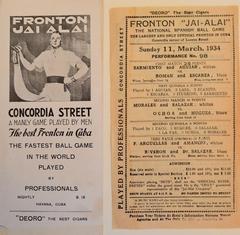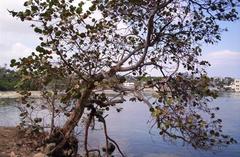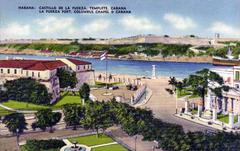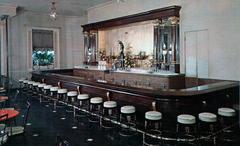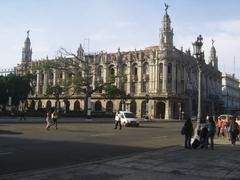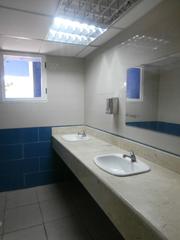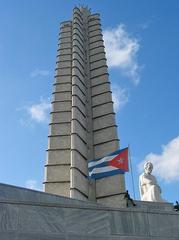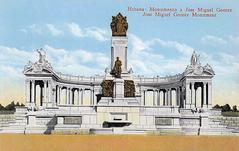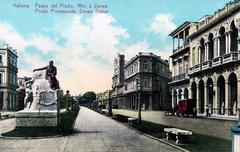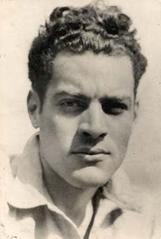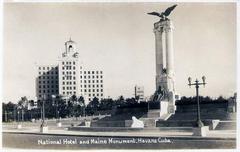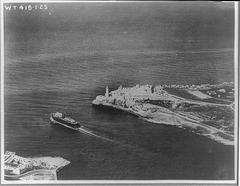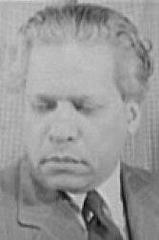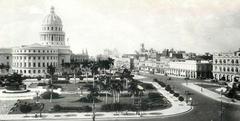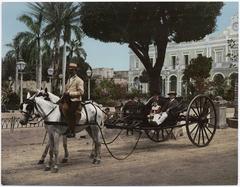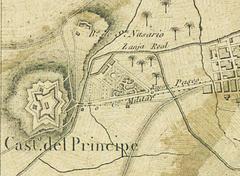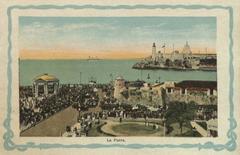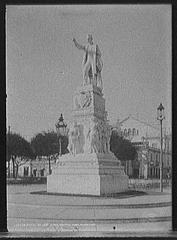
Iglesia de Santa María del Rosario: Visiting Hours, Tickets, and Historical Guide
Date: 04/07/2025
Introduction
Nestled in Havana’s rural municipality of Cotorro, the Iglesia de Santa María del Rosario is celebrated as the “Cathedral of the Cuban Countryside.” Built between 1760 and 1766, this landmark epitomizes Cuba’s colonial Baroque heritage, blending Spanish and Mexican ecclesiastical influences with local materials like limestone, cedar, and mahogany. Gilded altarpieces, vibrant frescoes by artists such as José Nicolás de Escalera, and octagonal towers make it a living museum of faith and artistry (Cubanet, Cuba Treasure).
Beyond architecture, the church remains the cultural and social heart of Santa María del Rosario, anchoring community life through festivals, art, and tradition. This guide details everything you need to plan a rewarding visit—exploring history, architecture, art, practical travel information, and local context. Whether you are passionate about history, art, or authentic cultural experiences, Iglesia de Santa María del Rosario is a Havana site not to be missed (onlinetours.es, lahabana.gob.cu).
Table of Contents
- Introduction
- Historical Background
- Architectural Highlights
- Artistic and Cultural Significance
- Visiting Information
- Community & Social Role
- Nearby Attractions & Practical Travel Tips
- Visitor Experience
- Frequently Asked Questions (FAQ)
- Conclusion
- References
Historical Background
Founded by royal decree in 1732 and completed in 1766, the Iglesia de Santa María del Rosario was built to serve the growing rural population and stands as a rare example of Cuba’s “Ciudad Condal.” Architect José Perera and local artisans crafted a church that replaced earlier chapels, incorporating both European and local influences (Cubanet). Over time, the church has undergone significant renovations, including the addition of distinctive octagonal towers and expanded naves.
Architectural Highlights
Exterior Features
The church’s façade is defined by two rare octagonal towers, influenced by Mexican ecclesiastical design, lending the building its unique silhouette. The robust limestone masonry, quarried locally, offers resilience against the Cuban climate. The main entrance, framed by pilasters and a curved pediment, is understated yet elegant. Above, a small oculus window lights the nave, while the tower’s square structure is crowned by a dome and cross (Cuba Treasure).
Interior Design
Inside, a single, spacious nave with side chapels and a wooden choir loft is supported by Tuscan columns and high vaulted ceilings. The use of local hardwoods for structural and decorative elements highlights the adaptation of European styles to Cuban resources. The dome and pendentives feature paintings by José Nicolás de Escalera, enhancing the church’s artistic value (EcuRed).
Surroundings
Set amidst a serene plaza shaded by ceiba trees, the church overlooks the countryside from its hilltop position. Nearby, the former Mercado del Cristo site (now a park) and the monument to poet Plácido enrich the cultural landscape.
Artistic and Cultural Significance
Colonial Baroque Architecture
The church is a quintessential example of Cuban colonial Baroque, marked by ornate details, strong masonry, and harmonious proportions. Its Latin cross plan, barrel vaults, and buttresses were advanced for the period and climate.
Artistic Treasures
A highlight is the gilded cedar and mahogany altarpiece, adorned with religious motifs and statues of the Virgin Mary and various saints. The church also houses a significant collection of liturgical silverwork and sacred art, much of it crafted in Havana’s colonial workshops (Arquidiócesis de La Habana).
Frescoes and oil paintings, some attributed to José Nicolás de Escalera, depict biblical scenes with both European and Cuban influences. Notably, one fresco is considered the first depiction of an enslaved Black person in Cuban art, offering both artistic and social commentary (lahabana.com; lonelyplanet.com).
Baroque Criollo Heritage
The church stands as a monument to “barroco criollo,” blending European Baroque forms with local craftsmanship. Its asymmetrical façade, single bell tower, and gilded cedar altars exemplify this heritage.
Preservation Efforts
Declared a National Monument in 1946 and reaffirmed in 1987, the church has benefited from restoration projects aimed at preserving both its architecture and art. Conservation efforts in the 20th and 21st centuries have addressed structural stability, humidity, termite damage, and the restoration of altarpieces and frescoes (Habana Patrimonial).
Visiting Information
Visiting Hours & Tickets
- Hours: Open Tuesday to Sunday, 9:00 AM–5:00 PM (closed Mondays and major holidays)
- Admission: Free; donations are appreciated to support preservation
Guided Tours
Local guides and parish volunteers offer tours with insights into the church’s history, art, and architecture. Advance booking is recommended, especially during peak seasons (TripAdvisor).
Accessibility
- The church is partially accessible: main areas have ramps, but some historic zones (like the choir loft and bell tower) require stairs.
- Visitors with mobility needs should request assistance in advance.
Photography & Etiquette
- Photography is allowed, but flash and tripods are discouraged to protect artworks.
- Modest attire is required; hats should be removed inside.
- Please respect the sanctity of the space, especially during services.
Community & Social Role
The church is more than a monument—it serves as the spiritual and cultural heart of the community. Annual festivals, such as the feast day of Our Lady of the Rosary, feature processions and cultural performances. The church’s organ, one of Cuba’s oldest, adds historical resonance to special events (Cuba Travel).
Nearby Attractions & Practical Travel Tips
- Nearby Sites: Loma de la Cruz hill, Casa de los Condes restaurant, artisan markets, and mineral baths offer further exploration.
- Getting There: Located about 20 km from Havana’s center, the church is accessible by taxi, car, or public bus (though bus schedules may vary). Advance transport planning is advised.
- Travel Tips: Visit on weekends to experience local festivals. Bring water, sun protection, and cash for donations or purchases.
Visitor Experience
Visitors are welcomed by a tranquil plaza and the church’s imposing façade. Guided tours and informational panels in Spanish and English enrich the experience. Photography opportunities abound, especially in the morning or late afternoon when natural light enhances the church’s colors and details.
Frequently Asked Questions (FAQ)
Q: What are the church’s visiting hours?
A: Tuesday to Sunday, 9:00 AM–5:00 PM; closed Mondays.
Q: Is there an entrance fee?
A: No, entry is free; donations support preservation.
Q: Are guided tours available?
A: Yes, with advance booking recommended.
Q: Is the church wheelchair accessible?
A: Partially; main zones are accessible, but some historic areas require stairs.
Q: Can I take photos inside?
A: Yes, but avoid flash and tripods.
Q: Are there special events or festivals?
A: Yes, especially on feast days and during cultural celebrations.
Conclusion
Iglesia de Santa María del Rosario stands as a vibrant testament to Cuba’s colonial, religious, and artistic legacy. Its architecture and art, from rare octagonal towers to gilded altarpieces and pioneering frescoes, make it a must-see for travelers interested in Havana’s hidden gems. The church’s ongoing role as a community anchor and the focus of preservation efforts ensure its relevance for generations to come.
Plan your visit to immerse yourself in Cuba’s colonial artistry and living tradition. For up-to-date information, virtual tours, and travel tips, explore the resources below and consider using the Audiala app for a curated cultural experience.
Visual Resources
References
- Visiting Iglesia de Santa María del Rosario: Hours, Tickets, and Architectural Highlights in Havana, 2024, Cuba Treasure (Cuba Treasure)
- Iglesia de Santa María del Rosario, 2024, EcuRed (EcuRed)
- Artistic Heritage of Iglesia de Santa María del Rosario, 2024, Arquidiócesis de La Habana (Arquidiócesis de La Habana)
- Churches of Havana: Colonial Architecture, 2024, Cubanet (Cubanet)
- Cultural and Social Context of Santa María del Rosario, 2024, onlinetours.es (onlinetours.es)
- Preservation Efforts at Iglesia de Santa María del Rosario, 2024, Habana Patrimonial (Habana Patrimonial)
- Visitor Reviews and Information, 2024, TripAdvisor (TripAdvisor)
- Cuba’s Colonial Churches and Religious Sites, 2024, Cuba Absolutely (Cuba Absolutely)
- lahabana.gob.cu
- lahabana.com
- lonelyplanet.com
- Cuba Travel





